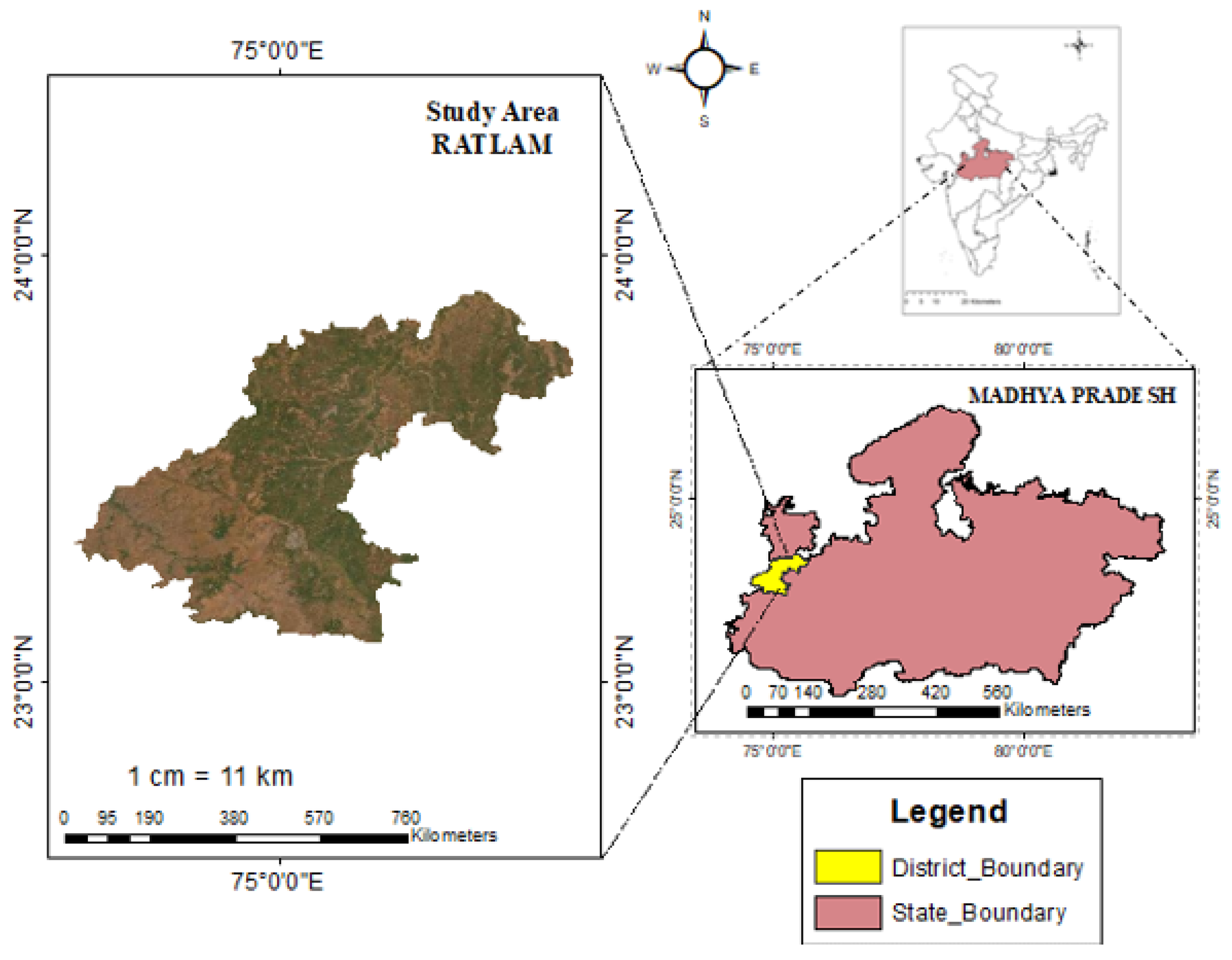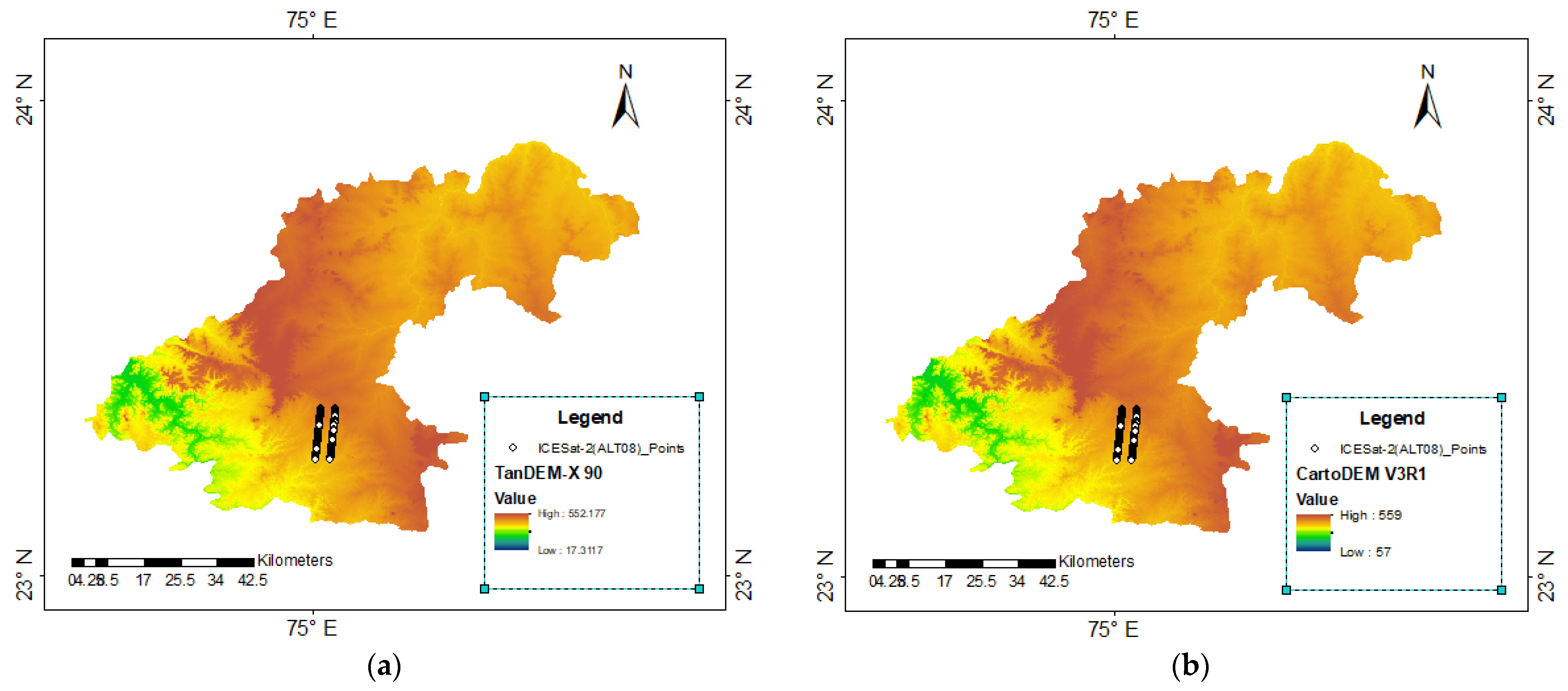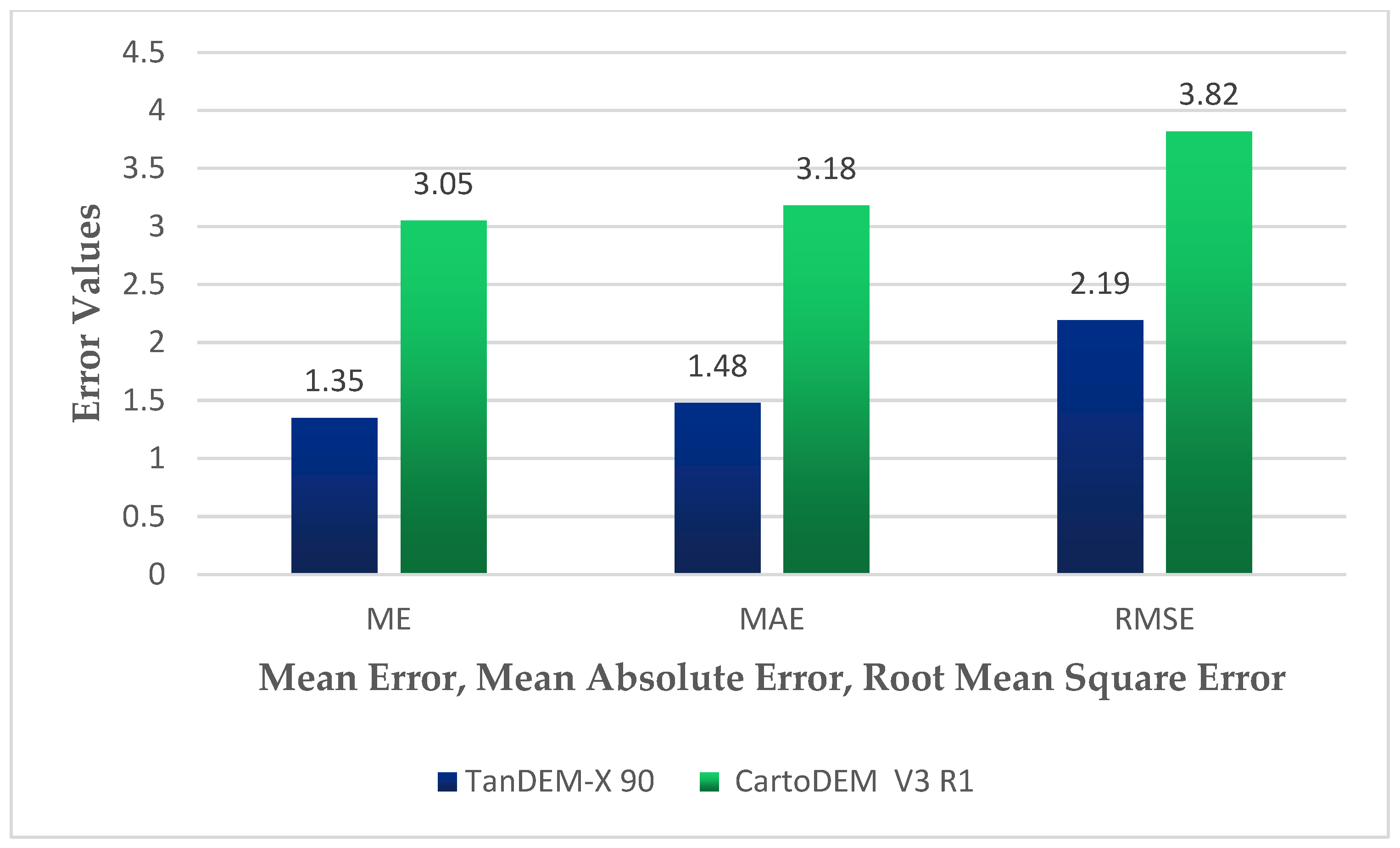Accuracy Assessment of TanDEM-X 90 and CartoDEM Using ICESat-2 Datasets for Plain Regions of Ratlam City and Surroundings †
Abstract
:1. Introduction
2. Material and Method
2.1. Study Area
2.2. ATLAS (ALT08)
2.3. TanDEM-X 90 DEM
2.4. CartoDEM V3 R1
2.5. Methodology
3. Results and Discussion
4. Conclusions
Author Contributions
Funding
Institutional Review Board Statement
Informed Consent Statement
Data Availability Statement
Acknowledgments
Conflicts of Interest
References
- Markus, T.; Neumann, T.; Martino, A.; Abdalati, W.; Brunt, K.M.; Csatho, B.; Farrell, S.; Fricker, H.; Gardner, A.; Harding, D.; et al. The Ice, Cloud, and land Elevation Satellite-2 (ICESat-2): Science requirements, concept, and implementation. Remote Sens. Environ. 2017, 190, 260–273. [Google Scholar] [CrossRef]
- Nandy, S.; Srinet, R.; Padalia, H. Mapping Forest Height and Aboveground Biomass by Integrating ICESat-2, Sentinel-1 and Sentinel-2 Data Using Random Forest Algorithm in Northwest Himalayan Foothills of India. Geophys. Res. Lett. 2021, 48, e2021GL093799. [Google Scholar] [CrossRef]
- Polidori, L.; el Hage, M. Digital elevation model quality assessment methods: A critical review. Remote Sens. 2020, 12, 3522. [Google Scholar] [CrossRef]
- Zhang, Y.; Pang, Y.; Cui, D.; Ma, Y.; Chen, L. Accuracy Assessment of the ICESat-2/ATL06 Product in the Qilian Mountains Based on CORS and UAV Data. IEEE J. Sel. Top. Appl. Earth Obs. Remote Sens. 2021, 14, 1558–1571. [Google Scholar] [CrossRef]
- Neuenschwander, A.; Pitts, K. The ATL08 land and vegetation product for the ICESat-2 Mission. Remote Sens. Environ. 2019, 221, 247–259. [Google Scholar] [CrossRef]
- Brunt, K.M.; Neumann, T.A.; Larsen, C.F. Assessment of altimetry using ground-based GPS data from the 88S Traverse, Antarctica, in support of ICESat-2. Cryosphere 2019, 13, 579–590. [Google Scholar] [CrossRef] [Green Version]
- Neumann, T.A.; Martino, A.J.; Markus, T.; Bae, S.; Bock, M.R.; Brenner, A.C.; Brunt, K.M.; Cavanaugh, J.; Fernandes, S.T.; Hancock, D.W.; et al. The Ice, Cloud, and Land Elevation Satellite—2 mission: A global geolocated photon product derived from the Aadvanced Ttopographic Llaser Aaltimeter Ssystem. Remote Sens. Environ. 2019, 233. [Google Scholar] [CrossRef] [PubMed]
- Amitabh, B.; Krishna, G.; Srinivasan, T.P.; Srivastava, P.K. An integrated approach for topographical mapping from space using Cartosat-1 and Cartosat-2 imagery. In International Archives of the Photogrammetry, Remote Sensing and Spatial Information Sciences; CiteSeerX: State College, PA, USA, 2008; Volume XXXVII, pp. 1355–1358. [Google Scholar]
- Jacobsen, K. ISPRS-ISRO Cartosat-1 Scientific Assessment Ptogramme (C-SAP) Technical Report—Test Areas Mausanne and Warsaw. 2006. Available online: http://citeseerx.ist.psu.edu/viewdoc/summary?doi=10.1.1.584.5348 (accessed on 7 April 2017).
- Bhardwaj, A.; Jain, K.; Chatterjee, R.S. Generation of high-quality digital elevation models by assimilation of remote sensing-based DEMs. J. Appl. Remote Sens. 2019, 13, 044502. [Google Scholar] [CrossRef]
- Yadav, U.; Bhardwaj, A. Accuracy Assessment of Openly Accessible CartoDEM V3R1 and TanDEM-X 90 Using Smartphone Having Assisted GPS for Ratlam City and Surroundings. 2021. Available online: https://ecsa-8.sciforum.net/ (accessed on 5 November 2021).




Publisher’s Note: MDPI stays neutral with regard to jurisdictional claims in published maps and institutional affiliations. |
© 2021 by the authors. Licensee MDPI, Basel, Switzerland. This article is an open access article distributed under the terms and conditions of the Creative Commons Attribution (CC BY) license (https://creativecommons.org/licenses/by/4.0/).
Share and Cite
Yadav, U.; Bhardwaj, A. Accuracy Assessment of TanDEM-X 90 and CartoDEM Using ICESat-2 Datasets for Plain Regions of Ratlam City and Surroundings. Eng. Proc. 2021, 10, 59. https://doi.org/10.3390/ecsa-8-11441
Yadav U, Bhardwaj A. Accuracy Assessment of TanDEM-X 90 and CartoDEM Using ICESat-2 Datasets for Plain Regions of Ratlam City and Surroundings. Engineering Proceedings. 2021; 10(1):59. https://doi.org/10.3390/ecsa-8-11441
Chicago/Turabian StyleYadav, Unnati, and Ashutosh Bhardwaj. 2021. "Accuracy Assessment of TanDEM-X 90 and CartoDEM Using ICESat-2 Datasets for Plain Regions of Ratlam City and Surroundings" Engineering Proceedings 10, no. 1: 59. https://doi.org/10.3390/ecsa-8-11441
APA StyleYadav, U., & Bhardwaj, A. (2021). Accuracy Assessment of TanDEM-X 90 and CartoDEM Using ICESat-2 Datasets for Plain Regions of Ratlam City and Surroundings. Engineering Proceedings, 10(1), 59. https://doi.org/10.3390/ecsa-8-11441






